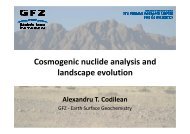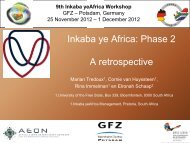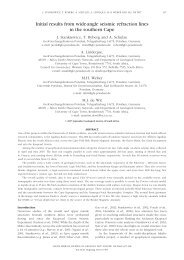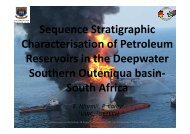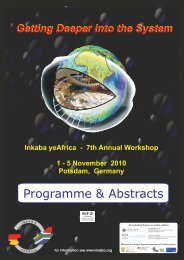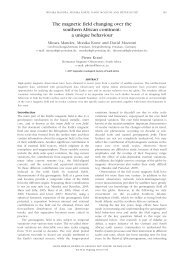South Africa - Inkaba.org
South Africa - Inkaba.org
South Africa - Inkaba.org
You also want an ePaper? Increase the reach of your titles
YUMPU automatically turns print PDFs into web optimized ePapers that Google loves.
Deterministic approach to geological and petrophysical<br />
modelling of field analogue data: A case study of Tanqua-<br />
Karoo (Kookfontein Formation) deltaic sequence, SW Karoo<br />
Basin (<strong>South</strong> <strong>Africa</strong>)<br />
W.A. Sonibare 1 , D. Mikeš 2 , A.O. Onaneye 3<br />
1. Dept of Earth Sciences, Stellenbosch University, <strong>South</strong> <strong>Africa</strong>, shoniwas@yahoo.com<br />
2. Dept of Earth Sciences, Stellenbosch University, <strong>South</strong> <strong>Africa</strong>, mikes@sun.ac.za<br />
3. Dept of Earth Sciences, Stellenbosch University, <strong>South</strong> <strong>Africa</strong>, Alfred.onaneye@gmail.com<br />
ABSTRACT<br />
In recent years, the use of three-dimensional digital computer models to characterise and manage hydrocarbon<br />
reservoirs with regards to resource evaluation and fluid flow prediction has become a widely accepted technique<br />
within the oil industry. These geological reservoir models are often stochastically derived from sparse subsurface<br />
datasets with poor resolution and inability to properly capture all scales of heterogeneity particularly small-scale<br />
heterogeneities. The resultant models are not robust in terms of realistic geological and sedimentological<br />
information. They lack accurate prediction of sediment-body geometry, internal facies architecture and spatial and<br />
temporal distribution of facies and their petrophysical values (i.e. porosity and permeability). Therefore, central to<br />
the success of any reservoir management technique (be it net-to-gross estimation for resource evaluation or<br />
upscaling of petrophysical properties in a reservoir simulator to predict field-scale fluid flow behaviour) is the<br />
accurate construction of a facies-dependent geological model.<br />
At the exploration and development stage of an oilfield when there exists little geological information,<br />
reconstruction of 3D stratigraphic and geometric elements from well-exposed outcrops could be a valuable tool.<br />
This study, therefore, presents an outcrop analogue study of the excellently exposed Permian Kookfontein deltaic<br />
succession in almost seven type-localities (Katjiesberg, Syfer, Skoorsteenberg, Bitterberg, Vaalberg<br />
Pienaarsfontein and Roosterberg ) with a lateral extent of about 72 km. Quantitative outcrop data will be analysed<br />
using facies, petrographic thin-section, gamma-ray log and photopanel analyses. A facies-dependent geological<br />
model will be constructed hierarchically honouring all scales of heterogeneity. Modelling of petrophysical<br />
properties will be based on the established facies distribution in our geological model, and performed in two steps:<br />
(1) estimation or measurement of porosity values from thin-section analysis, and (2) grain size-based empirical<br />
modelling of permeability values using Kozeny-Carman and Berg predictive methods. A correlation will then be<br />
established between Kozeny-Carman and Berg models. This deterministic procedure will allow evaluation of the<br />
relationships between depositional and diagenetic controls on the distribution of petrophysical properties in our<br />
study area.<br />
KEYWORDS: Geological and Petrophysical modelling, Field analogue data, Permian Kookfontein deltaic<br />
succession, Kozeny-Carman and Berg models.<br />
77



